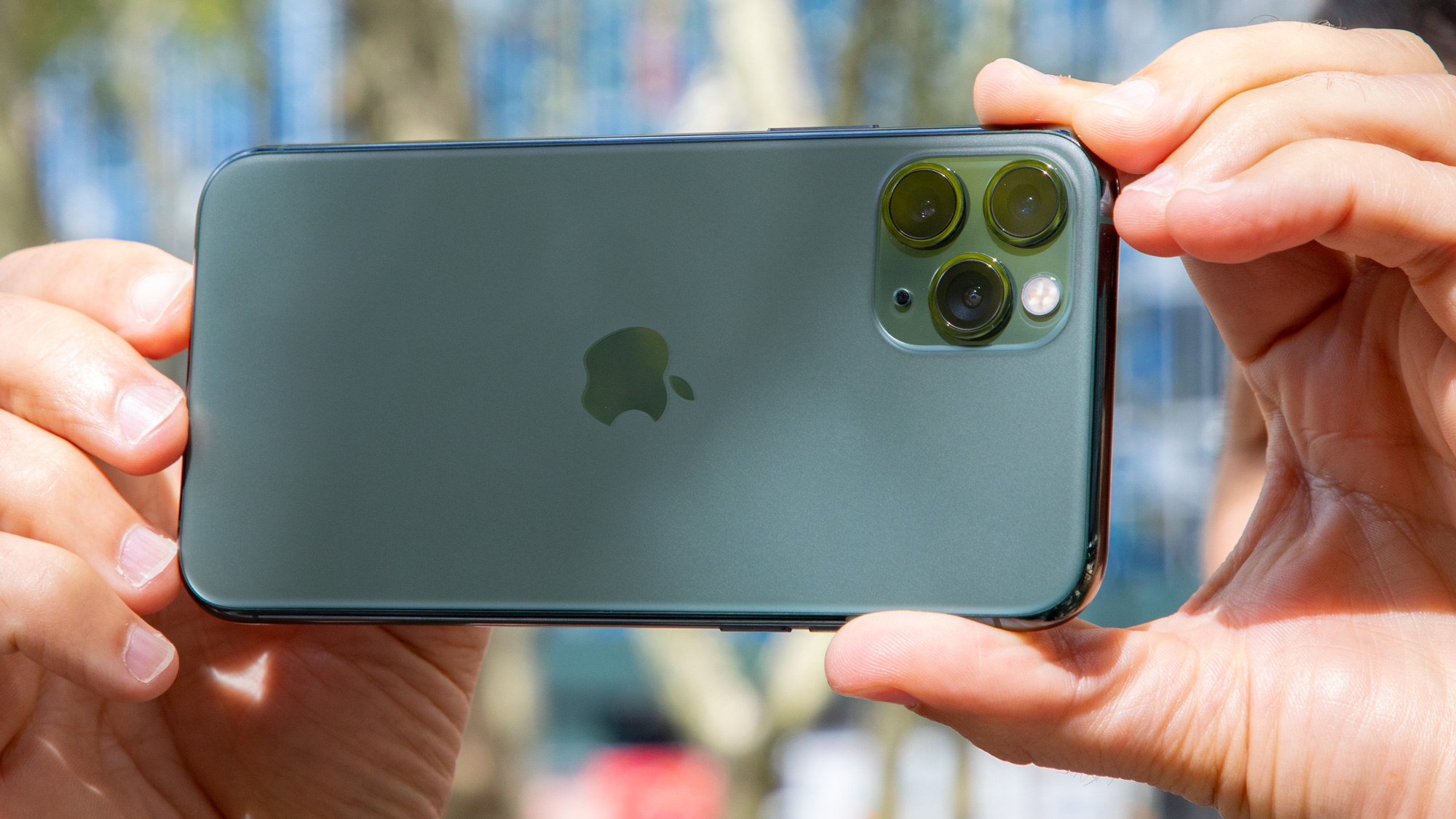Tom's Guide Verdict
The iPhone 11 Pro delivers amazing photo quality with its three cameras and best-in-class performance in a compact design.
Pros
- +
New triple cameras are fantastic
- +
A13 Bionic is fastest phone chip
- +
More durable glass front and back
- +
OLED display a lot brighter
- +
Longer rated battery life
Cons
- -
Shorter battery life than iPhone 11 Pro Max and iPhone 11
- -
Just 64GB of storage for starting price
- -
A bit heavier and thicker than iPhone XS
Why you can trust Tom's Guide
Apple may have since moved ahead with the iPhone 12 Pro, but the iPhone 11 Pro continues to provide big performance in a compact package. You get triple rear cameras offer amazing performance, complete with an ultra-wide lens, a new Night mode and better Smart HDR, plus extended dynamic range in video. Why more recent iPhones rank among the best camera phones around, the iPhone 11 Pro remains one of the best unlocked iPhones, if you can find it for a discounted price.
Other highlights include a very bright 5.8-inch display that's easy to use with one hand, a fast A13 Bionic processor that smokes the Android competition that came out at the same time and a fast charger in the box (finally) — something you won't get with any iPhone 12 model. Apple wins both our iPhone 11 Pro vs Galaxy S10 face-off and a more recent Samsung Galaxy S20 Plus vs. iPhone 11 Pro comparison. Read on for our full iPhone 11 Pro review.
Editor's note: Apple has discontinued the iPhone 11 Pro and iPhone 11 Pro Max (as well as the iPhone 12 Pro and iPhone 12 Pro Max); if you're looking for Apple's newest big phones, check out our iPhone 13 Pro review and our iPhone 13 Pro Max review.
iPhone 11 Pro review: Cheat Sheet
- The regular iPhone 11 offers great dual cameras, but the iPhone 11 Pro offers a third camera for optical zoom, giving you more range.
- Apple's new Night mode produces amazing results in very low light and even surpasses the Pixel 4 in some cases. (Our Pixel 4 vs. iPhone 11 Pro face-off has a full comparison between the two phones.)
- Thanks to its A13 Bionic processor, the iPhone 11 Pro is still the fastest phone you can buy today.
- At about 10.5 hours of battery life, the iPhone 11 Pro offers good endurance, but the iPhone 11 Pro Max lasts nearly 12 hours on a charge.
- The fast charger in the box works pretty well, getting you to 55% in 30 minutes.
- We wish Apple included more storage than just 64GB; you may want to go for a higher capacity.
- The iPhone 12 is right around the corner, and it'll include four variants ranging from 5.4-inch to 6.7-inch sizes, all with 5G support. Apple is expected to launch the iPhone 12 in October.
iPhone 11 Pro review: Price and availability
The iPhone 11 Pro debuted at $999 in 2019 for a relatively skimpy 64GB of storage. It's no longer part of Apple's iPhone lineup, though you can still find the iPhone 11 Pro at carriers and retail sites. Just make sure the price is less than the $999 you'd pay for a newer iPhone 12 Pro.
By comparison, the Galaxy Note 10 packs four times as much storage at 256GB, though Apple does a better job with compression than Android phones. You can pay $1,149 for 256GB of storage on the iPhone 11 Pro or $1,349 for 512GB.
If you’re a U.K. user, the iPhone 11 Pro used to cost £1,049 for the 64GB storage version, then £1,119 for 128GB and £1,399 for 256GB.
Be sure to check out our iPhones 11 deals page and Apple Store coupons to take advantage of any discounts on Apple's older iPhones.
iPhone 11 Pro review: Specs
| Row 0 - Cell 0 | iPhone 11 Pro |
| Starting Price | $999 |
| Screen (Resolution) | 5.8-inch Super Retina XDR Display (2436 x 1125) |
| CPU | A13 Bionic |
| RAM | Unknown |
| Storage | 64GB, 256GB, 512GB |
| MicroSD? | No |
| Rear Cameras | 12-MP wide (f/1.8), 12-MP ultra wide (f/2.4), 12-MP telephoto (f/2.0) |
| Front Cameras | 12-MP (f/2.2) |
| Water Resistance | Up to 4 meters for 30 minutes |
| Battery Size | Unknown |
| Battery Life (Hrs:Mins) | 10:24 |
| Size | 5.67 x 2.81 x 0.32 inches |
| Weight | 6.63 ounces |
| Colors | Gold, space gray, silver, midnight green |
iPhone 11 Pro review: Design
One look at the back of the iPhone 11 Pro and you know this phone means business. The three large camera lenses dominate the top left corner, and they're a bit intimidating at first. And while the iPhone 11 has friendly colors like green, purple and yellow, the iPhone 11 Pro sticks to conservative hues like midnight green, space gray, gold and silver.
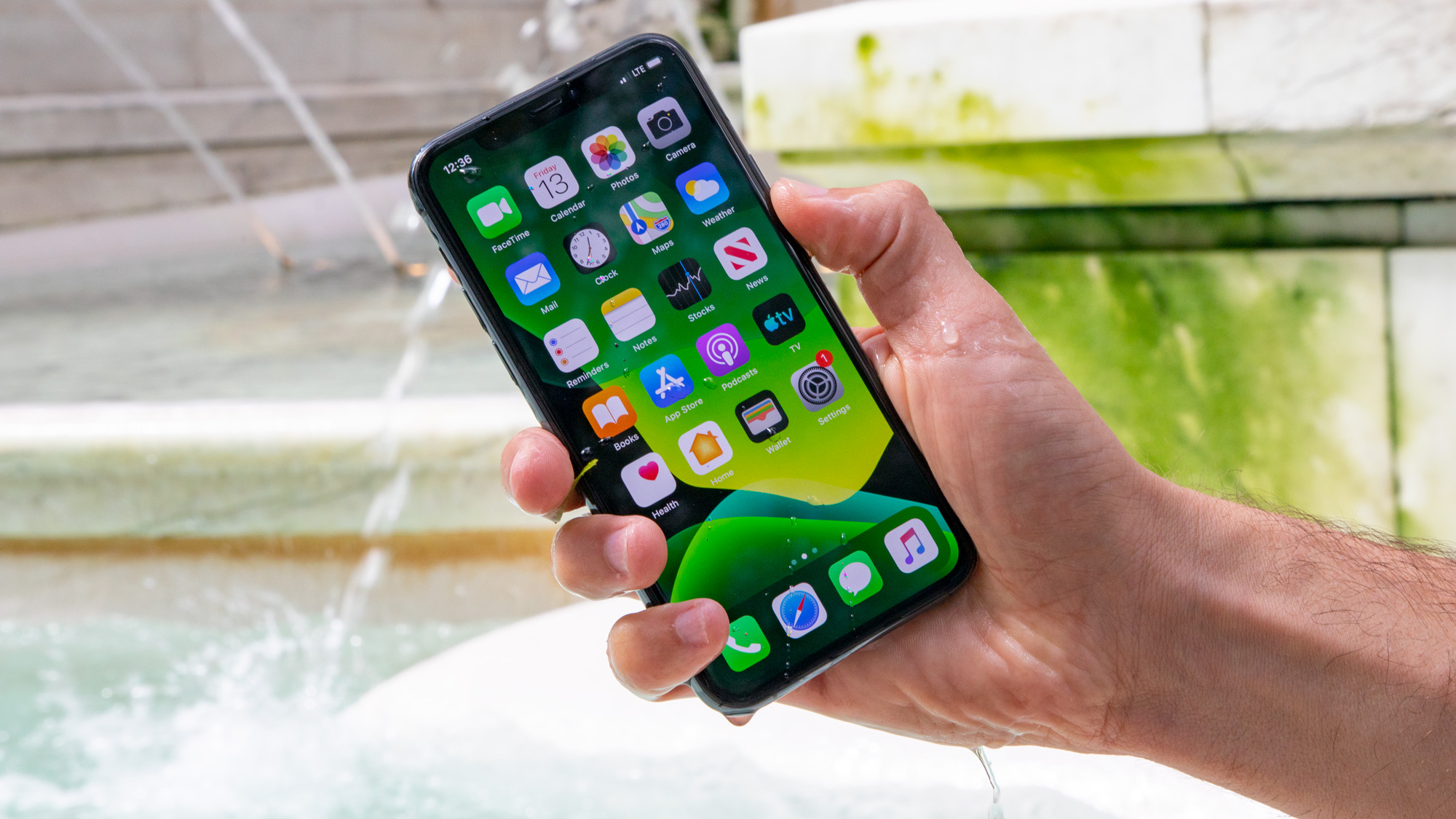
I really like the matte finish on the back; it not only resists fingerprints (I'm looking at you, Galaxy Note 10) but it's less slippery than other glass phones.
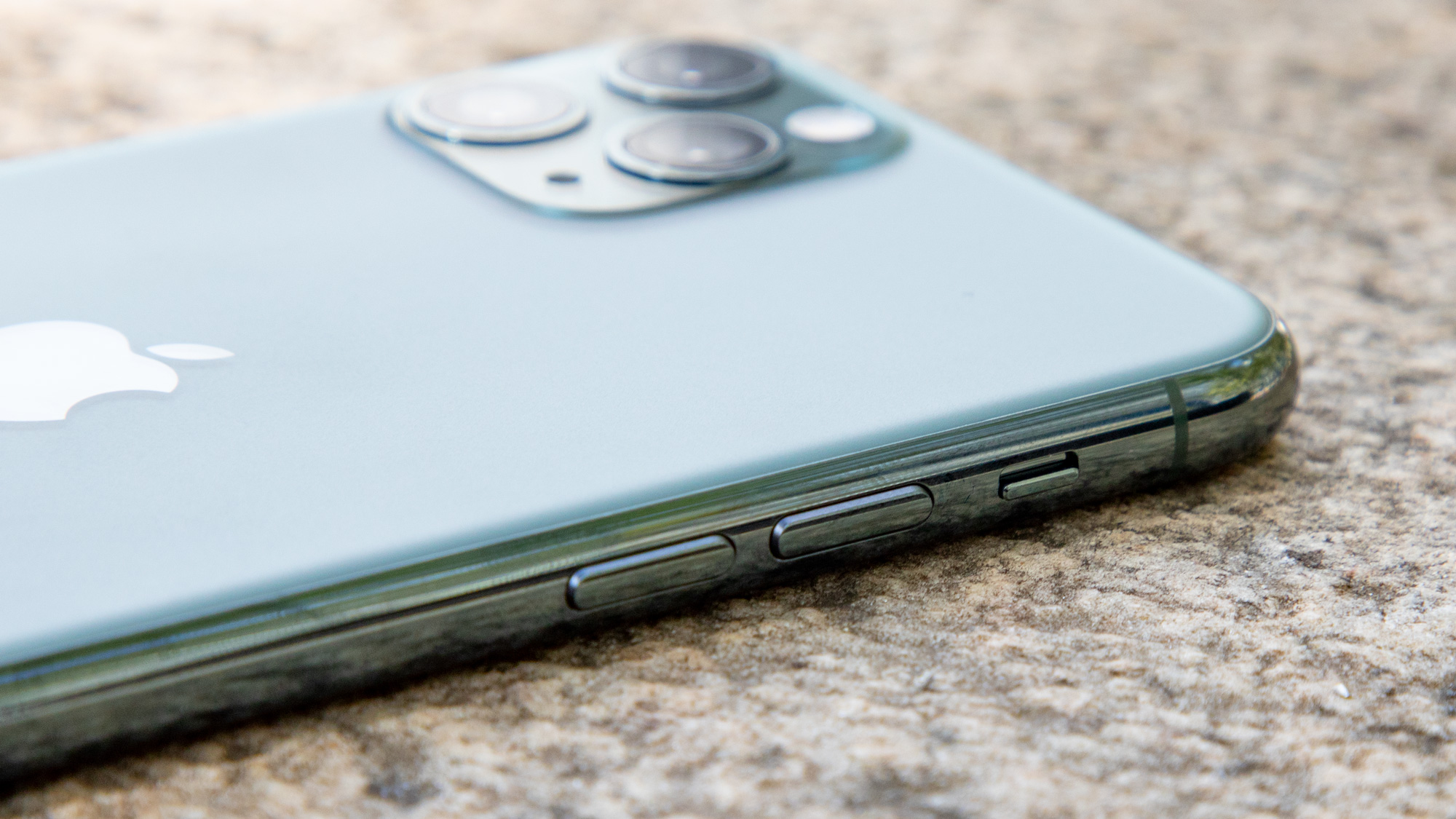
The iPhone 11 Pro has no trouble shrugging off water. I dumped it in a fountain and the phone didn't experience any issues. The device is IP68 rated and can withstand being submerged in up to 4 meters for up to 30 minutes. (That's a full 2 meters more than the iPhone 11 can withstand.)

There's a couple of things that I don't love about the iPhone 11 Pro's design. The first is that it's a bit heavier than the iPhone XS (6.63 ounces versus 6.24 ounces), and it's also slightly wider and thicker, which I suspect has to do with additions like the third camera and perhaps a larger battery. Nevertheless, it is still compact enough to top our list of the best small phones.
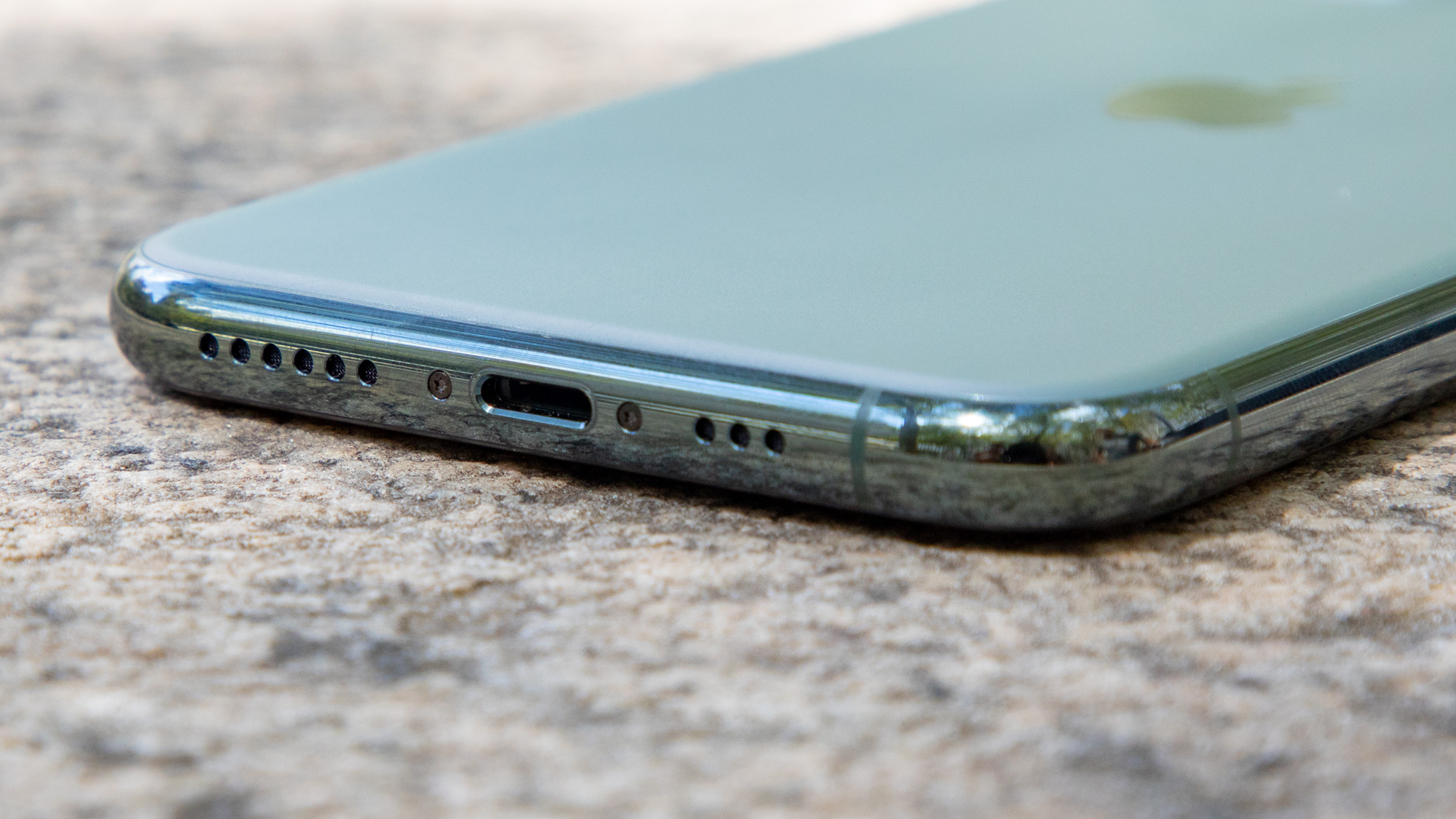
The second nitpick is that the iPhone 11 Pro looks nearly identical to recent iPhones from the front. Yes, the notch has become iconic at this point, but I'd like to see something closer to a full-screen iPhone.
iPhone 11 Pro review: Durability

Apple says the iPhone 11 Pro has the "toughest glass ever" in a smartphone. And we put that claim to the test by conducting an iPhone 11 Pro drop test from different heights onto a sidewalk. The results were not great.
At a height of about 3.5 feet, the iPhone 11 Pro's front cracked when we dropped the handset on its face. Interestingly, the back of the phone didn't suffer any damage when we dropped it from the same height, but the rear did crack from a shoulder-height drop. Regardless, we would invest in an iPhone 11 Pro case.
Some iPhone 11 Pro owners have complained that their screens have scratched easily. However, we have not encountered any issues with our review unit. If you are concerned about your phone picking up scuffs or scratches we'd suggest investing in a screen protector.
iPhone 11 Pro review: Display and audio
It's one thing to measure the brightness of the iPhone 11 Pro's 5.8-inch Super Retina XDR display in our labs. And it impressed the lab with an average reading of 752 nits. That far outshines the Galaxy Note 10 (674 nits) and last year's iPhone XS (611 nits).

But you especially notice the difference when you put the iPhone 11 Pro next to the Galaxy Note 10 outside. Even without a lot of sunlight, the iPhone 11 Pro's screen made the Note 10's panel look downright dim. I had to double-check that Samsung's phone was on max brightness.
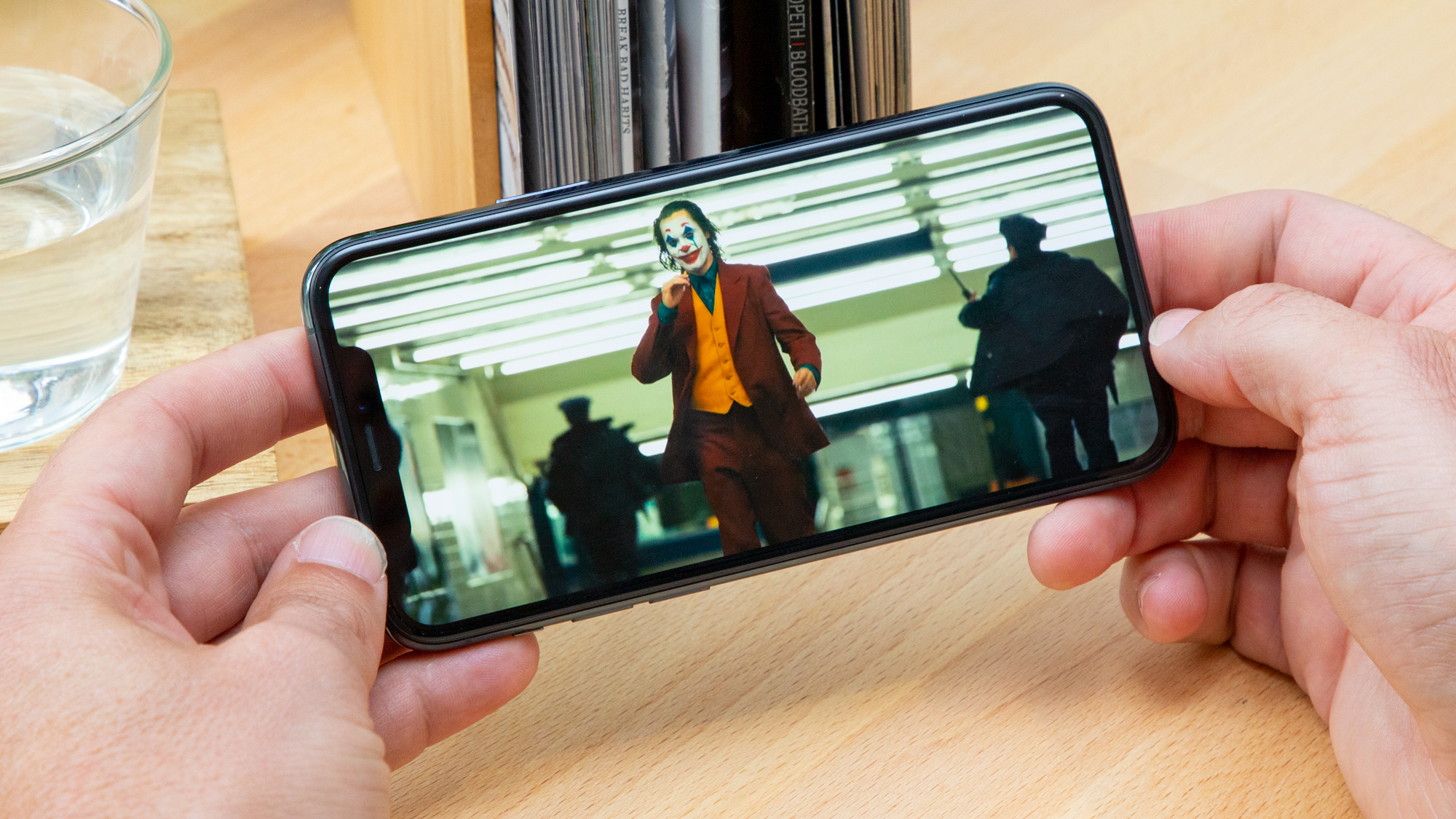
Overall, the OLED panel on the iPhone 11 Pro is pretty stunning, thanks to its wide color support and ultrawide viewing angles. In the trailer for See coming to Apple TV+, the sweeping landscapes and minute details in people's faces really drew me into the action, though I’d personally prefer the larger 6.5-inch canvas on the iPhone 11 Pro Max.
The sound through the iPhone 11 Pro is just as compelling, thanks to support for spatial audio and Dolby Atmos. When watching the See trailer, it felt like the driving rain on Jason Momoa's head was happening around me instead of just in front of me.
iPhone 11 Pro review: Cameras
With three lenses comprising the rear camera, backed by a wealth of computational photography smarts, the iPhone 11 Pro's new imaging stack is phenomenally ambitious, even by Cupertino's imaging standards.
It starts with a trio of 12-megapixel sensors, each tied to a different type of lens to offer a unique perspective on your surroundings. Like with the iPhone XS and iPhone X before it, there's a secondary telephoto shooter that offers 2x optical zoom, although Apple has widened the aperture to ƒ/2.0, up from ƒ/2.4 in last year's flagship to let in more light. Meanwhile, the new ultrawide camera delivers a 120-degree field of view, akin to a 0.5x zoom.
But it's not all about hardware. Apple’s new Night Mode finally enables the latest batch of iPhones to contend with Google and Huawei's benchmark low-light camera performance.
That's immediately clear from this striking shot of an outdoor bar, captured using the iPhone 11 Pro’s Night Mode. With an older iPhone in hand, you'd could never attain a shot this crisp and balanced in the highlights and shadows, at this time of the evening. Apple's low-light smarts plainly best Google's in this comparison, as the Pixel 3 has no answer for the detail present in the concrete slab, or in the patina of the wooden fence, as they were captured with the iPhone's primary lens.
I also love the darker, more realistic tone of the sky in the iPhone's example, and how Apple's hardware and software correct for the distortion that plagues the perimeter of the Pixel's attempt.
Google's newer Pixel 4 offers even better cameras, and you should check our iPhone 11 Pro vs Pixel 4 camera shootout to see how they stack up. Spoiler alert: Apple wins.
The iPhone 11 Pro's impressive performance in dim conditions proved to be a theme for the rest of the night. Inside a club, Apple's handset again paints a sharper, more lifelike view of a complex scene, mixing lighting of various colors with lots of intricate textures.
Compared with the image the Pixel 3 delivered, you can actually pick out the individual drivers shrouded behind the mesh of the speaker to the right of the room. And where Google's software dulls the spotlights considerably, Apple's seems more willing to allow those to shine brightly in certain places, which handily boosts the contrast and depth of the overall result.
The iPhone 11 Pro's camera is so stunning in the dark, that if you own one, your friends will assuredly designate you as the group's official photographer. They'll insist you take every shot — although, as we discovered, the iPhone 11 Pro's low-light capabilities have one weakness: portraits.
The new telephoto lens captures stunning shallow depth-of-field shots in the daytime, though it strangely produces portraits that are simultaneously noisy and blurry when lighting isn't ideal. And while I prefer the iPhone's warmer cast — it more naturally fits the true conditions of the venue — the Pixel 3's take is so much clearer, that almost doesn't matter. There's no reason the iPhone 11 Pro shouldn't be able to punch up dim portraits the same way it does typical night shots, so hopefully this can be corrected in a software update.
The iPhone 11 Pro's ultrawide lens similarly struggled to top the one on the back of Samsung's Galaxy Note 10 Plus inside New York City's iconic Grand Central Station. Every detail is a bit duller through the new iPhone's camera. Whether it's the shadows cutting across the pillars, or the separation between the bricks in the walls, or the carvings adorning the ceiling, Samsung's optics rendered it with more sharpness.
On the flip side, I much prefer the way Apple's ultrawide camera painted the view from the southwest corner of Bryant Park. Excluding the difference in sunlight in the background, the grass, fallen leaves and lettering on the signage in the foreground are just more discernible on the iPhone. I also love the way the camera's HDR processing brought out all the grays and whites lurking within the clouds in the sky. The contrast adds a richness and gravity to the scene that Samsung's phablet misses out on.
For this delectable close-up on a cookie, we used the primary lens on both the iPhone and Note. Even though Samsung's device packs an AI-aided Scene Optimizer that can recognize food and adjust exposure, contrast and saturation accordingly, it was Apple's handset that brought home the unmistakably more delicious shot. All the cookie's nooks and crannies are so much richer, both in color and depth, looking at the iPhone 11 Pro's result. The Galaxy somehow glosses over those intricacies.
Finally, we put the iPhone 11 Pro's new 12-MP front-facing camera to the test with an ultrawide selfie that seemed fuller of color and texture compared with the Note's best work. Samsung's software dials up the skin smoothing and opts for flatter, less saturated hues, which makes the photo look as if it were captured on a cloudy day, even though it wasn't. The improvement from the iPhone XS' 7-MP selfies is clear to see for users coming from that device, and I love how Apple has made it so easy to widen the field of view when shooting with the front-facing camera. You don't even need to tap anything — all you have to do is turn the phone from portrait to landscape orientation.
The iPhone 11 Pro's camera is so stunning in the dark, that if you own one, your friends will assuredly designate you as the group's official photographer.
In fact, the only thing I find more impressive than the iPhone 11 Pro's photography is how easy Apple has made it to use the camera app. This is a phenomenally advanced mobile imaging system, and yet it's not anywhere near as complicated to get the most out of, in practice, compared with the best camera phones from the likes of Huawei and Samsung.
For example, Night Mode is triggered automatically based on shooting conditions, but the phone still tells you how long the exposure will have to be before you even press the shutter button. A countdown commences as Night Mode shots are captured, which means you're not holding still indefinitely while you wonder how much time the camera needs to work its magic. Additionally, the new viewfinder experience, which shows other zoom perspectives in the overflow area behind the controls to give you a sense of what a wider vantage point can offer, is another brilliant idea. All mobile camera interfaces should be this straightforward.
The iPhone 11 Pro's photography gets even better with Apple's new Deep Fusion mode, which is part of the iOS 13.2 upgrade. Deep Fusion is sort of like traditional HDR, in that it comprises a wealth of differently-exposed frames. However, it goes a step further by analyzing each one at the pixel level.
Apple says the technology delivers unparalleled sharpness by incorporating elements of every photo for an optimized, ideal shot. And we did see a difference when we used Deep Fusion on the iPhone Pro versus the regular camera mode on the iPhone 11 Pro Max.
If you take a look at my colleague Rami in this portrait, you can make out his facial hair more clearly with Deep Fusion on, and there's more texture when you compare the inside of his hoodie across both images. There's not a huge difference, but it's noticeable.
iPhone 11 Pro review: Video
Apple has lavished unprecedented attention on the iPhone 11 Pro's video capabilities. Unlike most similarly priced flagships that can deliver only the highest frame rates and resolutions from a phone's primary camera, the Pro devices can capture 4K-resolution video at 60 frames per second from any one of their its rear lenses. What's more, even while you're shooting with one camera, your iPhone is priming the exposure levels and white balance of the other two sensors in the background, so that the transition from perspective to perspective is seamless.
The result is, quite simply, the finest video-recording experience I've ever enjoyed on a phone. Watching our sample video depicting a stroll through Bryant Park, the iPhone 11 Pro handles on-the-fly changes in lighting, lens switching and stabilization so much better than the quadruple-lens Galaxy Note 10 Plus. The difference in zooming in and out is especially jarring; on the iPhone, the transition is fast yet smooth, whereas the Note's is jerky and instantaneous. Additionally, Samsung's phablet clearly sustains a few hiccups at the outset of the video, dropping a handful of frames somewhat embarrassingly mere moments after I begin rolling.
The result is, quite simply, the finest video-recording experience I've ever enjoyed on a phone.
This iPhone is also the first capable of shooting slow-motion video at 120 fps through the front-facing camera. You might wonder why someone might use such a feature, but Apple has prepared an answer for that: Slofies. All iPhone 11 models make it possible to document super-slow footage of your hair blowing in the wind or a pie to the face.
The results certainly maintain parity with the high-quality video you can get using the back cameras, though we'll have to wait to find out whether the slofie becomes ubiquitous, or fizzles out like a passing fad, in much the same way Animojis did.
iPhone 11 Pro review: Performance
In less surprising news, Apple once again has the world's fastest phone, thanks to the iPhone 11 Pro’s A13 Bionic chip. This processor offers 20% faster CPU, GPU and machine-learning performance, and it shows in benchmark testing and real-world tests.
On Geekbench 5, which measures overall performance, the iPhone 11 Pro scored 1,337 on the single-core portion of the test and 3,509 on the multicore test. The Galaxy Note 10 mustered 746 and 2,640 on the same tests, while the OnePlus 7 Pro also trailed the iPhone 11 Pro at 744 and 2,802.
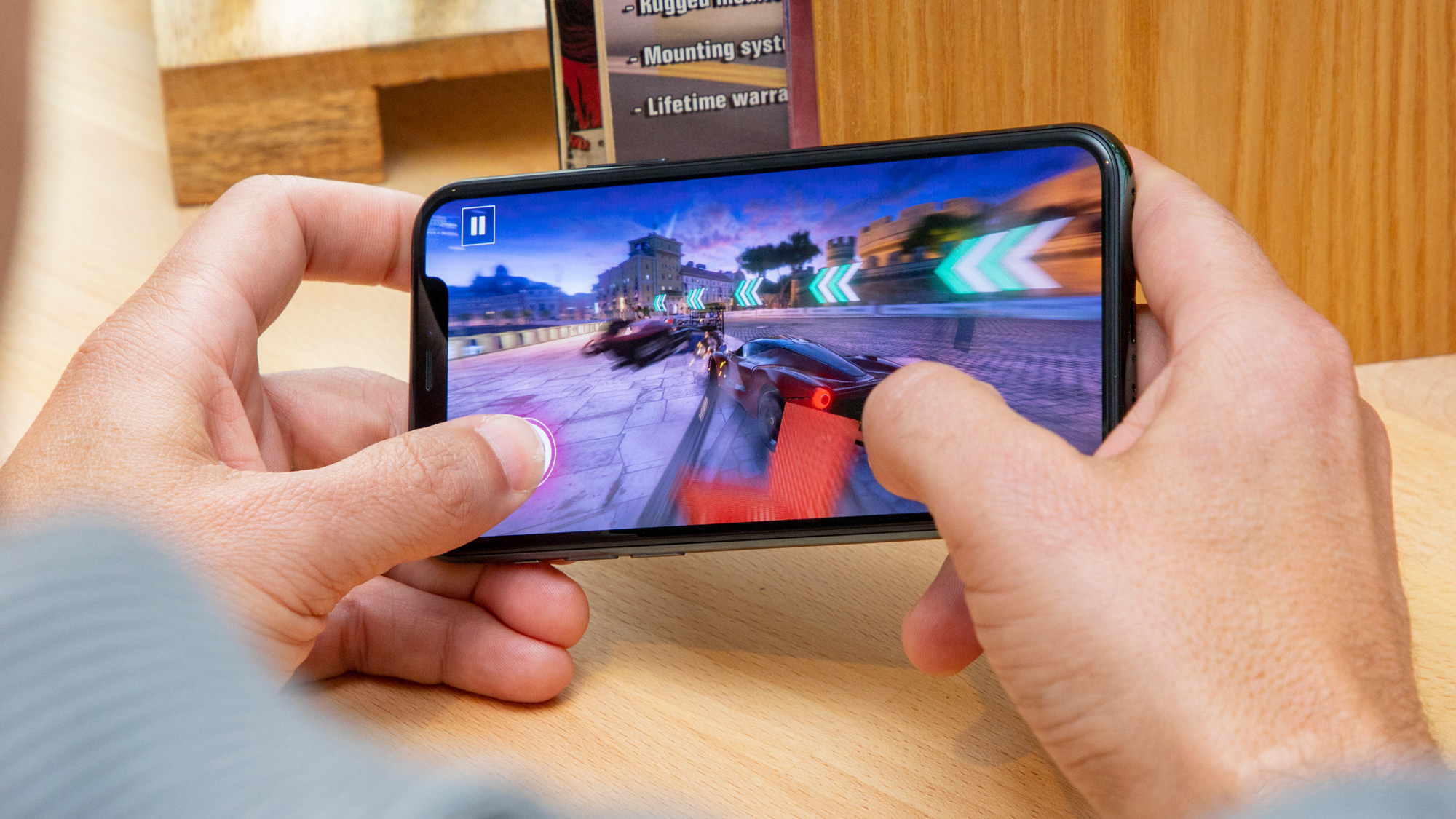
The iPhone 11 Pro also dominated on the GFXBench graphics test. This handset scored 2,174 frames, or 33.8 fps, on the Aztec Ruins (High Tier) off-screen benchmark, compared with 1,058/16 fps for the Note 10.
Apple's phone impressed again on the 3DMark Slingshot Extreme test, another graphics benchmark. The iPhone 11 Pro notched 6,163, while the Note 10 (5,374) and the OnePlus 7 Pro (5,581) fell behind.
On our real-world performance test, the iPhone 11 Pro shined once more, but it wasn't any faster than its predecessor this time around. It took the phone 46 seconds to export a 4K video to 1080p after applying a color filter and transition. The Galaxy Note 10 Plus took 1:34.
iPhone 11 Pro review: Battery life and charging
Because it's a smaller phone, I didn't expect the iPhone 11 Pro to outlast the iPhone 11 or the iPhone 11 Pro Max, but it performed well given its size. The phone lasted an average of 10 hours and 24 minutes on the Tom's Guide battery test, which involves continuous web surfing over 4G LTE on 150 nits of screen brightness.
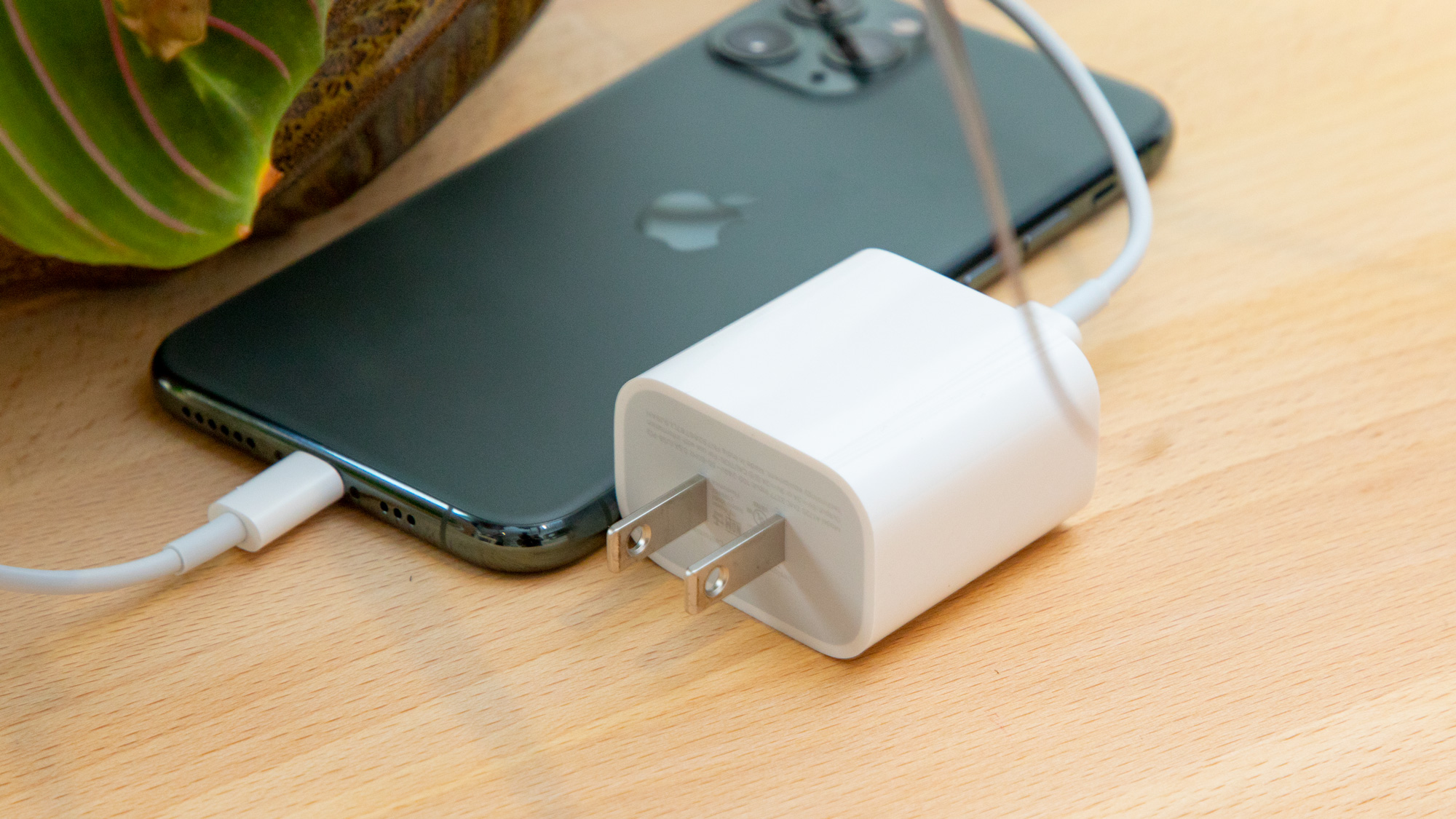
By comparison, the iPhone 11 lasted an average of 11:16 on our test, with the iPhone 11 Pro Max enduring for a whopping 11:54.
In the iPhone 11 Pro vs. Samsung's S10 face-off, the Galaxy S10's runtime of 10:19 is similar to the iPhone 11, but the Galaxy S10 Plus lasted a much longer 12:35. Interestingly, the Galaxy Note 10 endured for just 9:25, while the Note 10 Plus hit 11:09 on average. The OnePlus 7 Pro eked out only 9:31.
I’m glad that Apple has finally bundled a fast charger with an iPhone. The iPhone 11 Pro ships with an 18-watt charger that got to 55% juice in only 30 minutes. That's great, and outpaces the Note 10's 25-watt charger (47% in 30 minutes). However, the OnePlus 7 Pro hit 60% with its 40-watt charger in the same time frame.
iPhone 11 Pro: Is the lack of 5G a big deal?
The short answer to the above question is not really — at least at this moment. The fact that the iPhone 11 Pro lacks 5G is disappointing in the sense that you're probably going to hold onto this phone for the next few years. By then 5G should be everywhere, but right now the 5G networks are still being built out, and the speeds they're offering aren't appreciably better than what the latest LTE infrastructure offers.
So you’ll have to settle for 4G LTE on this phone, and the iPhone 11 Pro supports 4x4 MIMO, giving you two more antennas than the regular iPhone 11. The iPhone 11 Pro also comes with Wi-Fi 6 built in, which means you should enjoy more efficient throughput if you buy a Wi-Fi 6 router.
One wireless surprise is Apple's proprietary U1 chip, which uses Ultra Wideband to accurately locate other nearby devices with the same chip inside. For example, you can share files over AirDrop with other iPhone 11 or iPhone 11 Pro owners by pointing your phone in their direction, and the transfers will be handled more efficiently than before. But I’m guessing that more exciting applications are on the way, such as the rumored object tracker from Apple that would take on devices like the Tile.
iPhone 11 Pro review: Software
Apple's iOS 13 came preloaded on the iPhone 11 Pro, and it brought some welcome improvements. I especially appreciated Sign in with Apple, which made it easier to sign in with all sorts of apps without having to futz with passwords — or worry as much about my privacy.
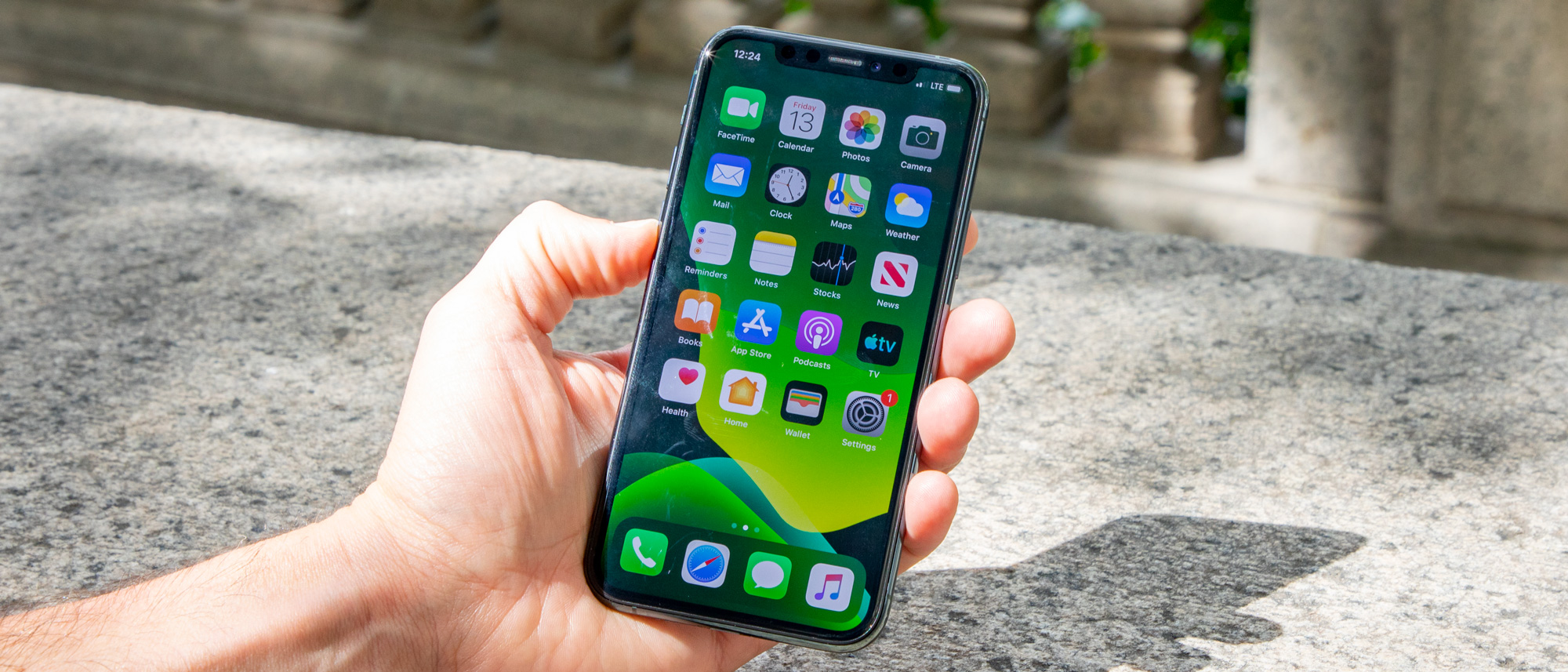
But right out of the gate I really appreciate the new Photos app. The Days, Months and Years views help your pics come alive, and I like the way Apple mixes in videos with still photos.
While I'm not giving up Google Maps anytime soon (Apple burned that bridge for me and then gave me incorrect directions back to the bridge), I'm glad that there's a new Maps app that's been rebuilt from the ground up with high-res 3D photos. There's also a Look Around feature that's similar to Google's Street View.
It's a small thing, but I like the redesigned Reminders app, as there are more in-your-face counters to see at a glance how many items on a to-do list you still need to complete.
Of course, since this review initially posted, Apple released iOS 14, which brought even more features to all iPhones, including the iPhone 11 Pro. (Our iOS 14.5 review has the latest assessment of those capabilities.) And this fall, the iPhone 11 Pro will support iOS 15.
iPhone 11 Pro review: Verdict
The iPhone 11 Pro continues to be one of the last great small phones in existence. And that's no small feat when you consider all of the great stuff Apple packed into this phone. You get arguably the best cameras in a phone along with class-leading performance and an OLED display that outshines most Android phones.
My only reservations with the iPhone 11 Pro are its measly 64GB of included storage and that its battery life, while good, trails both the iPhone 11 and iPhone 11 Pro Max.
If it were my dough, I would spend the extra $100 on the iPhone 11 Pro Max for its bigger screen and extra endurance. (Or I'd buy a new iPhone like the iPhone 12 Pro, which has a 6.1-inch display.) But the regular iPhone 11 is still very much worth the investment for those who desire killer cameras in a more compact package.
Mark Spoonauer is the global editor in chief of Tom's Guide and has covered technology for over 20 years. In addition to overseeing the direction of Tom's Guide, Mark specializes in covering all things mobile, having reviewed dozens of smartphones and other gadgets. He has spoken at key industry events and appears regularly on TV to discuss the latest trends, including Cheddar, Fox Business and other outlets. Mark was previously editor in chief of Laptop Mag, and his work has appeared in Wired, Popular Science and Inc. Follow him on Twitter at @mspoonauer.
